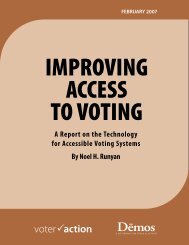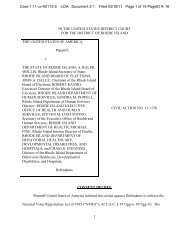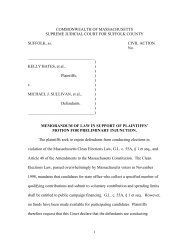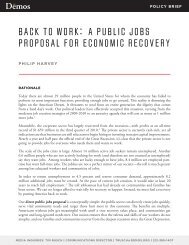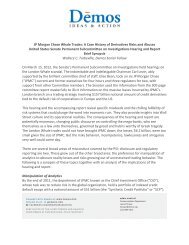how to raise the phone bill of the average new jersey family
how to raise the phone bill of the average new jersey family
how to raise the phone bill of the average new jersey family
- No tags were found...
You also want an ePaper? Increase the reach of your titles
YUMPU automatically turns print PDFs into web optimized ePapers that Google loves.
And CloseCall America is only a small operation with an estimated $8.9 million in sales nationwide, hardly aviable competi<strong>to</strong>r <strong>to</strong> Verizon.When California Policymakers Examined <strong>the</strong> Results <strong>of</strong> Four Years <strong>of</strong> Landline Deregulation in that State, TheyFound that There Still Was Little Real Competition. The report by <strong>the</strong> California Senate Rules Committeefound that California’s two largest <strong>phone</strong> companies -- AT&T and Verizon -- <strong>to</strong>ge<strong>the</strong>r control 85 percent <strong>of</strong> <strong>the</strong>state’s residential landline <strong>phone</strong>s. “All <strong>the</strong> evidence points <strong>to</strong> <strong>the</strong> existence <strong>of</strong> market dominance by AT&T andVerizon, which allows <strong>the</strong>m <strong>to</strong> <strong>raise</strong> prices without losing market shares.” 47Even where two viable competi<strong>to</strong>rs exist, many analysts don’t find that competition delivers effective pricecompetition <strong>to</strong> protect consumers. Such “duopoly” markets lead <strong>to</strong> what analysts at The Utility Reform Networkidentified as “price leadership”, where:[A]lternative providers simply follow <strong>the</strong> price actions <strong>of</strong> <strong>the</strong> dominant tele<strong>phone</strong> companies. Observedpricing reflects <strong>the</strong> actions <strong>of</strong> firms that recognize that consumers have little choice, and <strong>the</strong> result has beendramatic rate increases for many consumers.” 48With just a few choices in most markets, such limited competition in <strong>the</strong>se markets end up prone <strong>to</strong> pricematching and collusion ra<strong>the</strong>r than real price competition.WIRELESS AND VOIP SERVICES ARE NOT A COMPETITIVE SUBSTITUTE FORWIRELINE TELEPHONE SERVICESOne <strong>of</strong> <strong>the</strong> most ideological aspects <strong>of</strong> S 2664 is that it declares that local <strong>phone</strong> markets are “competitive”where <strong>the</strong>re are wireless <strong>phone</strong> services available—de fac<strong>to</strong> requiring deregulation <strong>of</strong> lan line <strong>phone</strong> servicesthroughout <strong>the</strong> state.Yet, Almost All Evidence Indicates that Wireless Phone Services are Not an Adequate Substitute for ExistingLandline Services, ei<strong>the</strong>r in providing an affordable alternative or in providing <strong>the</strong> services many landline usersneed.In California, where a similar assumption was made in regula<strong>to</strong>ry policy, The Utility Reform Network in its2010 report found that nei<strong>the</strong>r wireless, nor competitive local exchange carriers, nor VoIP technologies “<strong>of</strong>fer<strong>the</strong> overwhelming majority <strong>of</strong> consumers a reasonable means <strong>to</strong> substitute for <strong>the</strong> local tele<strong>phone</strong> services…There are numerous reasons <strong>to</strong> believe that because <strong>of</strong> <strong>the</strong>se limitations on choice, market forces are notsufficient <strong>to</strong> protect consumers from market power.” 49In fact, <strong>the</strong> Federal Communications Commission (FCC) has itself found that wireless providers, “ra<strong>the</strong>r thanproviding a complete substitute for traditional wireline service…largely provide mobile wireless telephonyservice <strong>to</strong> a cus<strong>to</strong>mer’s existing wireline service.” 50Notably, in a 2009 report, <strong>the</strong> National Center for Health Statistics found that New Jersey had one <strong>of</strong> <strong>the</strong>lowest rates <strong>of</strong> “wireless-only” households (8 percent <strong>of</strong> households) compared <strong>to</strong> an <strong>average</strong> <strong>of</strong> 14.7 percen<strong>to</strong>f households in <strong>the</strong> nation as a whole, indicating that for many state residents, wireless is not an adequatesubstitute and traditional landline service provides value <strong>to</strong> consumers, whe<strong>the</strong>r because <strong>of</strong> price or servicequality. 51Since families where members are over age 65 are strongly correlated with being dependent on landline services,S 2664 will have a disproportionate effect on <strong>the</strong> elderly in New Jersey. 52Wireless is Not an Adequate Substitute for Multiple Reasons. Wireless plans are much more expensive thanwireline services, so <strong>the</strong>y do not provide a pricing constraint on landline services. Wireless coverage varies basedon terrain, foliage and building structure and cannot guarantee calls made indoors. Signal strength varies fordifferent locations. 53 Note that Verizon itself in its Verizon Wireless Cus<strong>to</strong>mer Agreement makes clear thatquality <strong>of</strong> wireless is not as dependable as landline service:“Wireless devices use radio transmissions, so unfortunately you can’t get Service if your device isn’t in range<strong>of</strong> a transmission signal. And please be aware that even within your Coverage Area, many things can affect<strong>the</strong> availability and quality <strong>of</strong> your Service, including network capacity, your device, terrain, buildings,foliage and wea<strong>the</strong>r.”13 How To Raise The Phone Bill Of The Average New Jersey Family: What S 2664 Will Do To NJ Consumers




